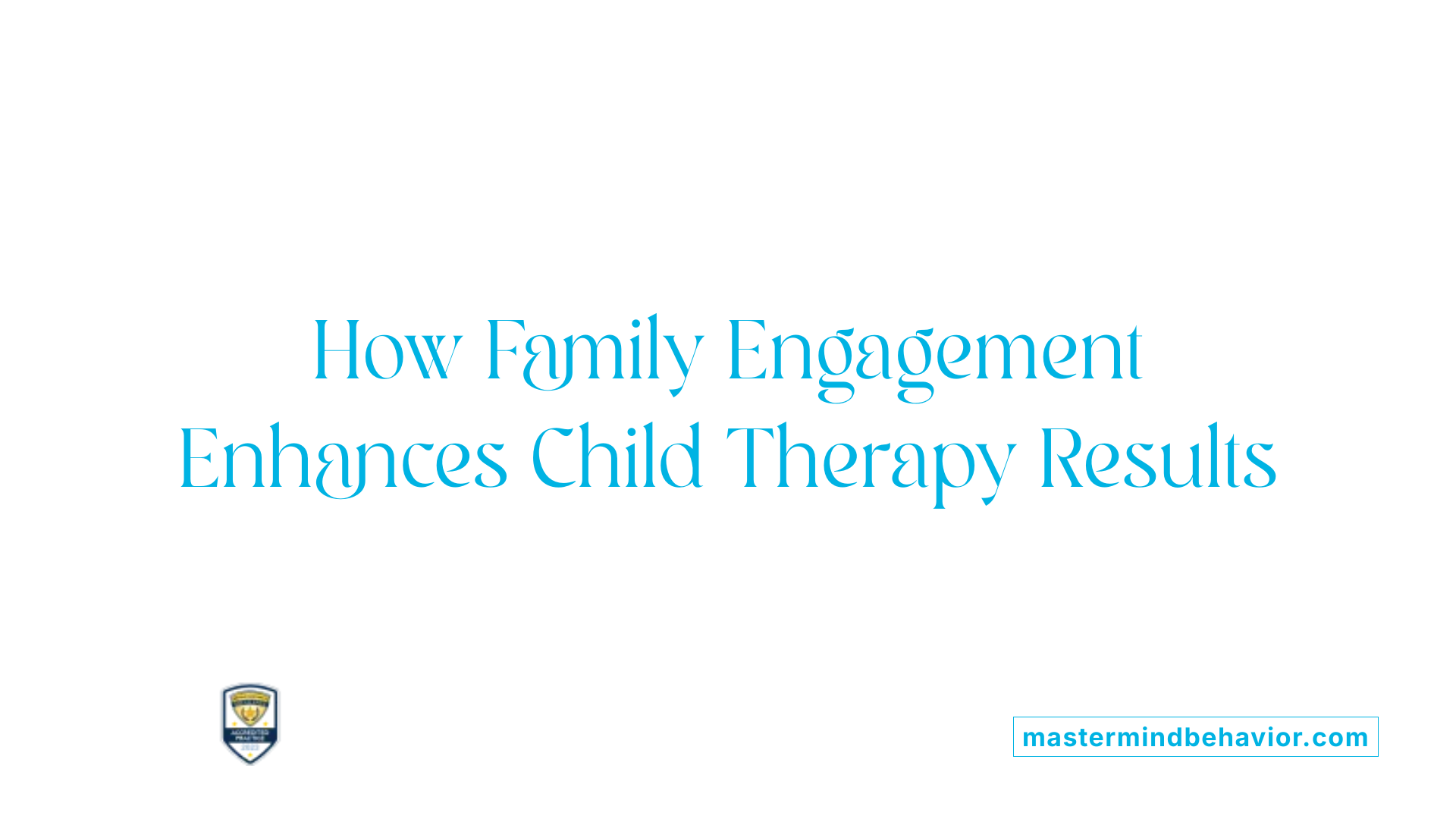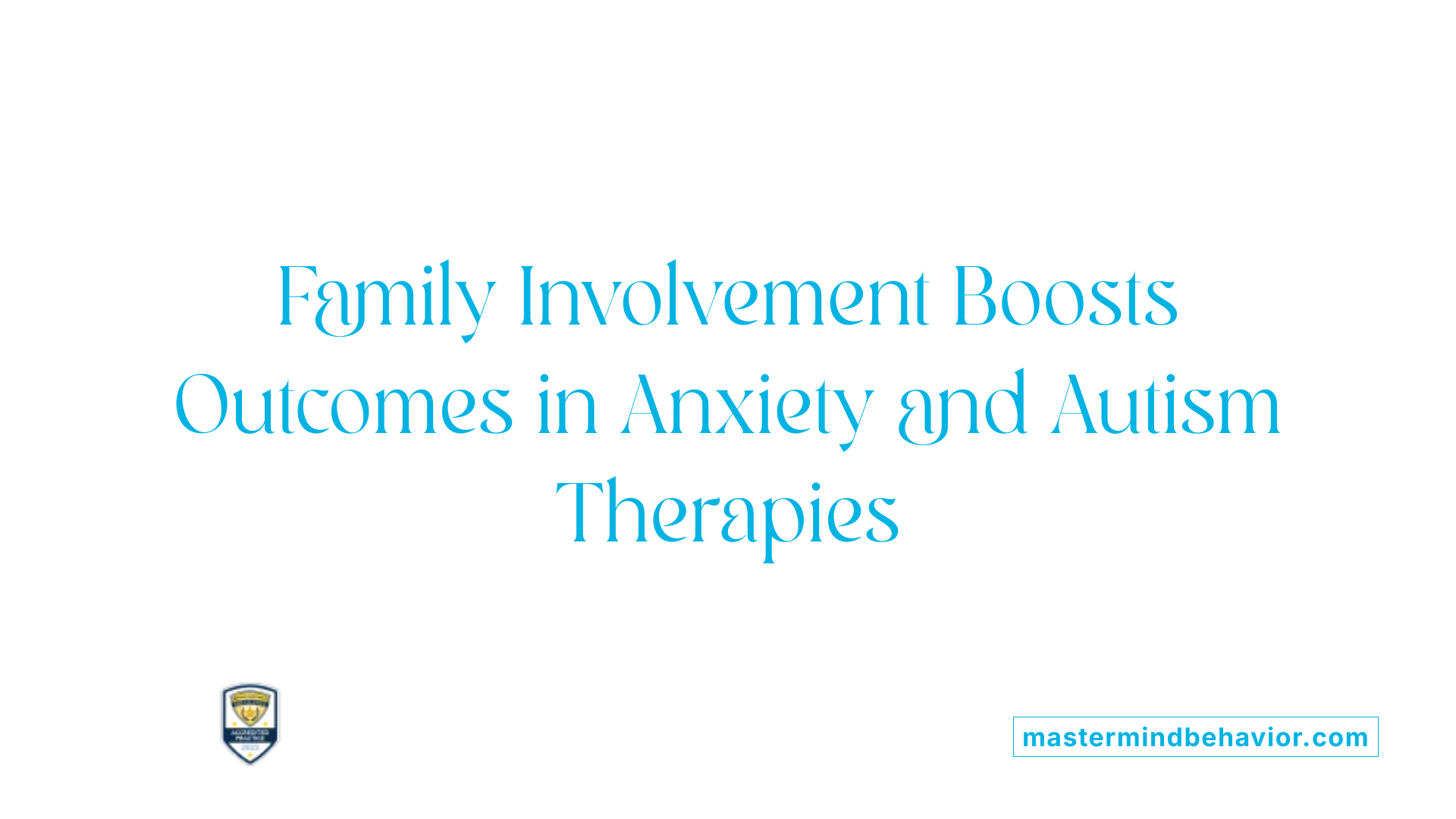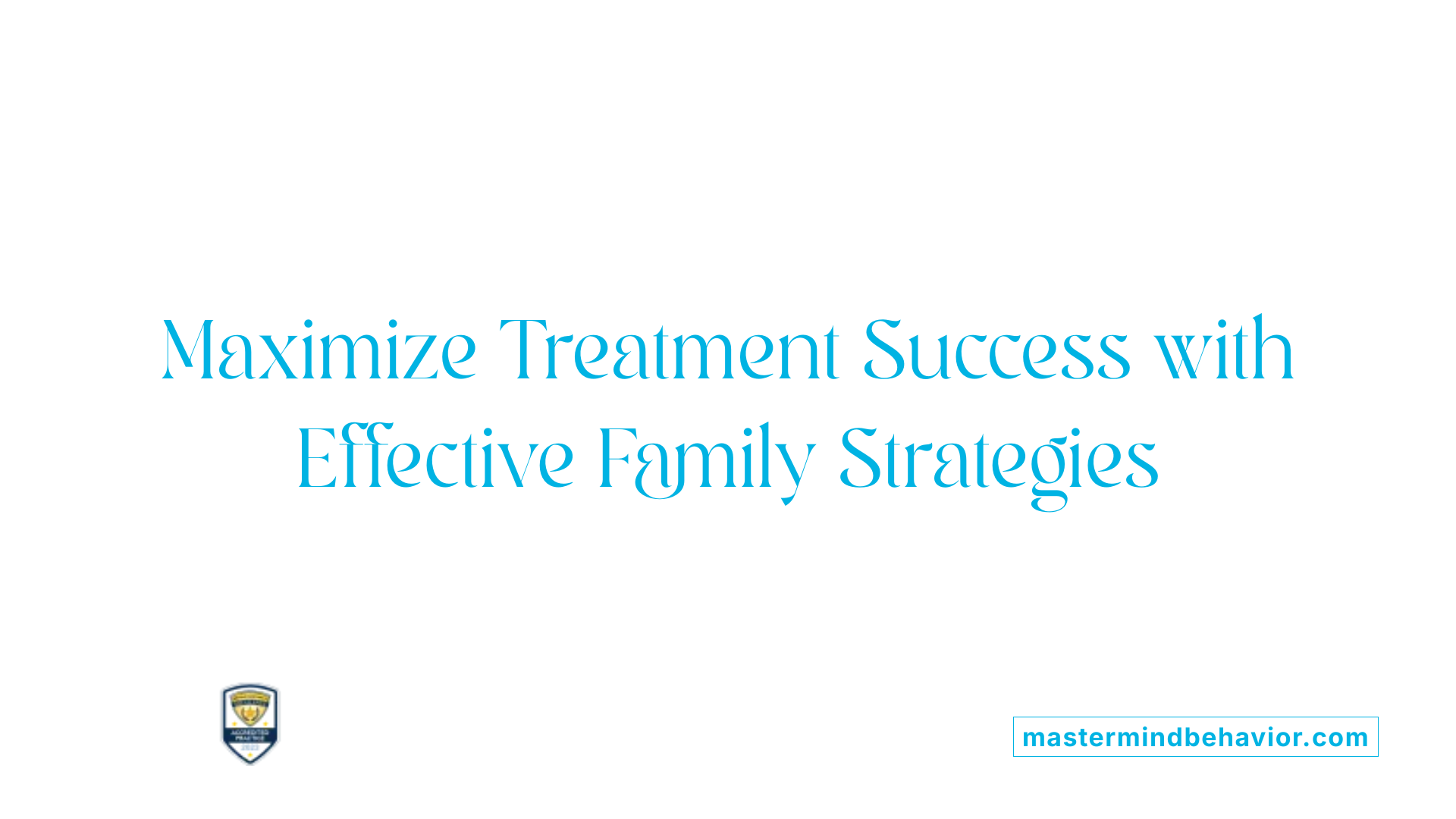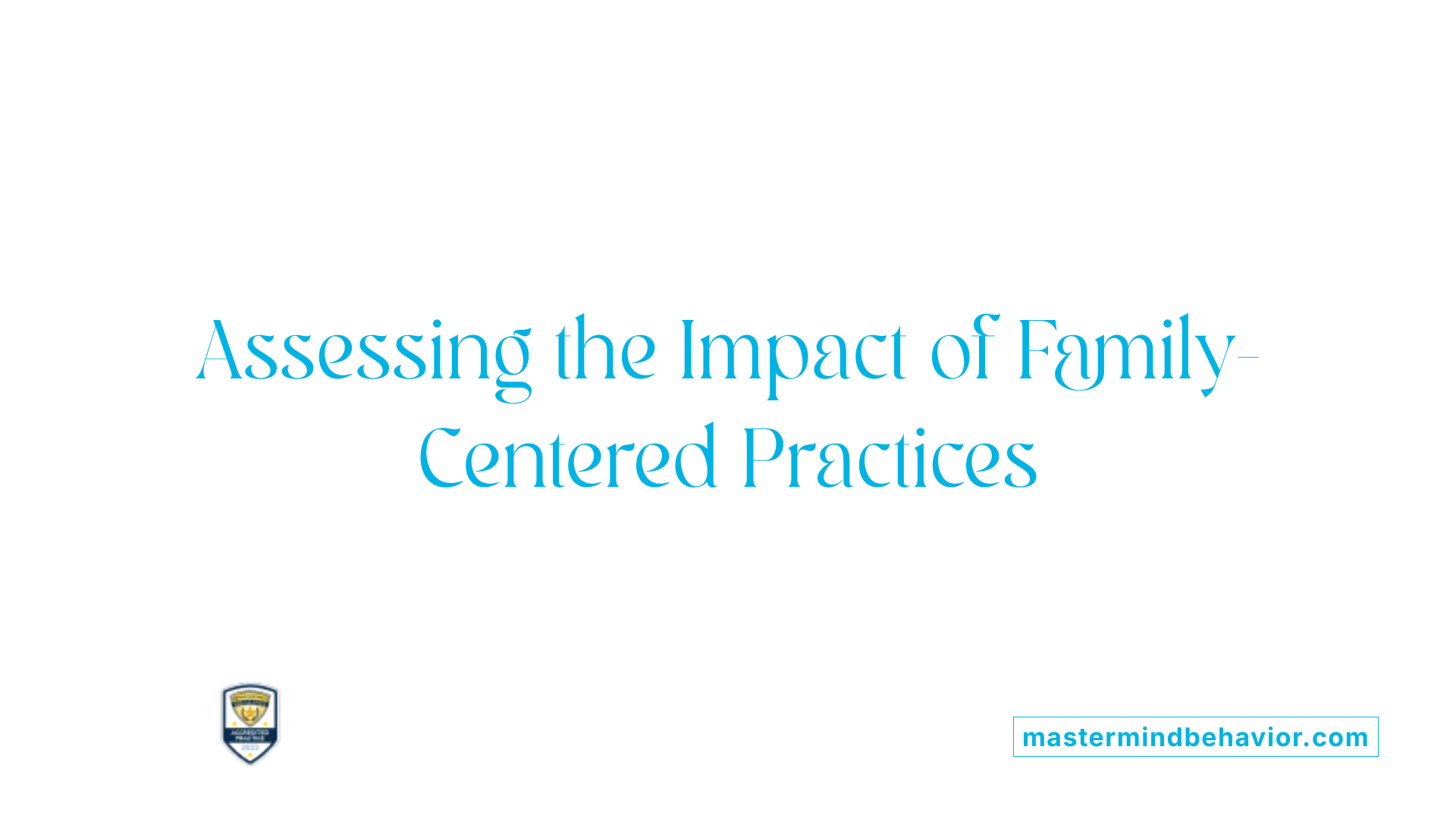The Critical Role of Family in Therapeutic Success
Involving parents and families in child and family therapy not only enriches the treatment process but also significantly improves outcomes across various mental health conditions. This article explores the importance of family involvement, effective engagement strategies, family dynamics' influence on success, and the evidence supporting family-centered practices in therapy.
Understanding the Components of Engagement in Therapy
What are the attitudinal and behavioral components of engagement?
Engagement in child and family mental health treatment involves two main parts: attitudinal and behavioral. The attitudinal part refers to the feelings, beliefs, and attitudes towards therapy—like motivation, satisfaction, and willingness to participate. These shape how open and receptive families and children are to treatment.
The behavioral component involves actual actions taken during therapy. Participation engagement is a critical behavioral element, which includes active involvement in therapy sessions and at home. This means not just attending appointments but actively engaging in activities, asking questions, sharing opinions, and following through on homework or action plans.
Why is participation engagement important?
Participation engagement signifies meaningful involvement in the treatment process. It goes beyond mere attendance, emphasizing active, conscious effort in therapy sessions and at home.
Active participation fosters better understanding, skill acquisition, and generalization of strategies outside of sessions. It ensures families and children are truly part of the change process, increasing the likelihood of positive outcomes.
How does active participation at sessions and home improve treatment effectiveness?
Active engagement during sessions allows therapists to tailor strategies effectively based on real-time feedback and behaviors. When families follow through with activities at home, they reinforce skills learned, create consistency, and support the child's progress.
This continuous involvement helps sustain therapeutic gains, making the intervention more impactful and lasting. Research shows that higher participation at sessions and at home correlates with better treatment outcomes.
What is Parent Participation Engagement (PPE)?
PPE encompasses behaviors like sharing opinions, asking questions, participating in therapeutic activities, and adhering to home action plans. It is distinct from the therapeutic alliance, focusing specifically on active measures taken by parents.
Studies report that PPE is associated with increased attendance and engagement, although attendance alone doesn’t fully reflect active participation. Measuring PPE often involves ratings of participation, observation of specific behaviors, and tracking homework completion, but tools vary in validation.
Factors influencing PPE and its impact
Various factors influence PPE, including parent demographics (age, income, education), level of motivation, satisfaction with treatment, barriers faced, parenting practices, and treatment phase. Findings are inconsistent, but overall, higher PPE relates to improved functioning and reduces impairment.
Strategies like reinforcement by providers, psychoeducation, rapport building, and barrier assessment generally enhance PPE. These strategies, despite limited fidelity measurement, show positive effects.
The importance of involving parents in therapy
Active parent participation improves therapy outcomes and helps in managing conditions like oppositional defiant disorder, conduct disorder, anxiety, and autism. Most clinicians believe parent involvement is crucial, especially for complex or disruptive cases.
Factors such as child diagnosis, age, and parent stress influence decisions about involvement. Properly engaged parents help tailor interventions, understand their child better, and support skill transfer at home.
How family participation complements individual therapy
Family therapy offers emotional stability and insight into familial dynamics. Family involvement can improve communication, reduce negative patterns, and address root causes of behavioral and emotional problems.
Regular collaboration, sharing progress, addressing concerns, and customizing strategies make therapy more effective. Resources like educational materials and support groups assist ongoing family engagement.
Involving families in CBT for anxiety and disorders
Family involvement can significantly improve outcomes in CBT for anxiety or related issues. Engaged families model healthy behaviors, reinforce strategies, and address family-level challenges.
Research suggests that more sessions involving family members generally lead to better results, especially when targeting family communication, accommodation behaviors, and maladaptive beliefs about anxiety.
Parental skills and behavior change
Training parents to reduce negative reinforcement and promote positive reinforcement is associated with greater relief of child anxiety symptoms. Specifically, behaviors like the 'protection trap'—parents' instinct to shield children from anxiety-provoking situations—can inadvertently maintain anxiety.
Modifying such behaviors results in improved therapy response. About 80% of children respond well to parent-involved interventions, higher than standard CBT outcomes.
The role of family in autism treatment
Family participation in autism therapy enhances social, emotional, and behavioral development. It promotes consistency across environments, improves communication, and empowers parents to be active advocates.
Training families in behavioral strategies supports skill development and reduces challenging behaviors. Regular family involvement fosters emotional security and helps families manage stresses, contributing to positive developmental outcomes.
| Aspect | What It Involves | Impact on Therapy |
|---|---|---|
| Participation Behaviors | Sharing opinions, asking questions, completing homework | Enhances engagement, reinforces strategies |
| Family Dynamics | Communication, conflict resolution, roles | Addresses root issues, promotes healthier relationships |
| Strategies | Psychoeducation, rapport building, barrier assessment | Improves PPE, increases retention |
| Treatment Outcomes | Symptom reduction, functioning, impairment | Better when parents actively involved |
| Modalities | Individual therapy, family therapy, CBT | Varies with family participation |
Final thoughts
Engagement in therapy, especially participation engagement by parents and families, is crucial for effective treatment. Utilizing diverse measures and strategies can optimize involvement, leading to stronger outcomes for children with various mental health conditions.
The Positive Impact of Family Involvement on Therapy Outcomes

What are the benefits of involving families in child and family therapy?
Involving families in therapy offers many advantages that extend beyond the individual child to improve family functioning as a whole. Active participation helps enhance communication within the family, fostering understanding and empathy among members. It encourages families to work together, strengthening bonds and creating a more supportive environment.
Family participation is also vital for reinforcing skills learned in therapy. When parents and siblings practice new coping, communication, and emotional regulation strategies at home, it helps make therapeutic gains more sustainable.
Moreover, engaging families allows caregivers to better understand the child's condition, manage symptoms effectively, and collaborate with clinicians on tailored treatment plans. This collaboration addresses family dynamics, helps resolve conflicts, and promotes healthy routines and roles.
Overall, involving families amplifies therapy's impact, supporting long-term positive changes and fostering resilience within the household.
Family Therapy's Role in Understanding Family Dynamics
How does family dynamics influence treatment success?
Family dynamics profoundly impact the effectiveness of mental health treatment, especially for children and adolescents. They encompass the patterns of interactions, communication styles, and relationships that shape the emotional climate within a family.
Supportive family environments with open communication, mutual respect, and adaptability often facilitate better engagement in therapy and lead to more positive outcomes. Such settings promote resilience and encourage ongoing participation from family members.
On the other hand, dysfunctional dynamics—such as persistent conflict, enmeshment, or rigidity—can create barriers to progress. These issues may contribute to ongoing stress, undermine treatment strategies, and hinder the child's emotional growth.
Assessing family patterns through family therapy and psychoeducation enables clinicians to tailor interventions that strengthen supportive relationships while addressing problematic behaviors. Involving families as active partners in treatment creates a nurturing environment that supports sustainable recovery.
Ultimately, family involvement helps establish a consistent support network outside of therapy sessions, which is crucial for maintaining gains and fostering long-term well-being.
| Family Dynamic Aspect | Impact on Treatment | How Addressed in Therapy |
|---|---|---|
| Communication Patterns | Affects understanding and cooperation | Psychoeducation, communication skills training |
| Conflict Resolution | Influences emotional climate | Family counseling, conflict management skills |
| Family Roles | Shapes responsibilities and behaviors | Role clarification, renegotiation strategies |
| Hierarchies and Boundaries | Impact autonomy and support | Boundary setting, family reorganization |
What is the significance of understanding family roles in therapy?
Recognizing the roles played by family members is crucial for effective therapy. These roles—such as the caretaker, the scapegoat, the hero, or the mediator—dictate how family members behave and respond to stress, expectations, and conflict.
By identifying these roles, clinicians can pinpoint sources of dysfunction and develop targeted interventions to promote healthier interactions. For example, shifting a parent from a caretaker role overly involved in controlling to one that supports autonomy can reduce tension.
Understanding family roles also enables family members to reflect on their behaviors and responsibilities. This awareness encourages renegotiation of relationships, which fosters mutual understanding and reduces maladaptive patterns.
Addressing and realigning these roles helps create a balanced and supportive environment, especially beneficial for children facing emotional or behavioral challenges. It promotes clearer boundaries, more effective communication, and shared responsibility.
| Role Type | Influence on Family Dynamics | Therapeutic Strategy |
|---|---|---|
| Caretaker | Overprotection or neglect | Role clarification, boundary setting |
| Scapegoat | Hidden source of tension | Reframing, empowerment strategies |
| Hero | Overachievement pressure | Encouragement of authentic self |
| Mediator | Suppresses conflict | Conflict resolution training |
In summary
Family therapy emphasizing the understanding of family patterns and roles plays a pivotal role in treatment success. It creates a foundation for healthier communication, resolves conflicts, and promotes adaptive behaviors.
By addressing the complex interplay of family relationships, clinicians can facilitate meaningful change, improve emotional well-being, and enhance the overall effectiveness of mental health interventions for children and their families.
Research-Based Evidence Supporting Family-Centered Practices
What evidence supports the importance of family-centered practices in therapy?
Incorporating family-centered practices into therapy has been extensively supported by research demonstrating their positive impact on long-term behavioral and emotional outcomes for children. Evidence indicates that family involvement enhances treatment adherence, increases engagement levels, and reduces the likelihood of subsequent placements in institutional settings. For instance, long-term follow-up studies reveal that children who participate in family-centered care exhibit sustained improvements in emotional regulation and social functioning.
The model of Family Centered Treatment (FCT), which is rooted in systemic and trauma-informed approaches like Eco-Structural Family Therapy and Emotionally Focused Therapy, emphasizes strengthening familial bonds and resilience. These approaches focus on understanding familial dynamics and addressing past traumas that influence current behaviors. Research shows that when families are active participants, therapy outcomes are more durable and meaningful.
Implementing family-centered care as a standard practice fosters partnerships between families and clinicians. This approach involves shared decision-making, respecting family values, and tailoring interventions to individual family contexts. Such practices improve communication, foster mutual understanding, and support culturally competent services. In inpatient and outpatient settings, initiatives like family-centered rounds and the Medical Home model have demonstrated effectiveness in improving coordination of care and health outcomes.
Overall, the evidence underscores that integrating family strengths, preferences, and active participation into therapy strategies significantly enhances overall effectiveness. This inclusive approach not only produces better immediate results but also contributes to sustained positive change over time.
How does research validate the effectiveness of family participation in therapy?
Research actively validates the critical role of family participation in achieving successful therapy outcomes. Studies have shown that actively engaging families during treatment increases adherence to therapeutic recommendations and boosts engagement, which are both linked to more durable improvements.
Trauma-informed and systemic family therapy models, such as Eco-Structural Family Therapy and Emotionally Focused Therapy, underscore the importance of nurturing emotional connections among family members. These models aim to reinforce family bonds, which are vital accelerators of healing, especially in families with histories of trauma.
Across various settings—including inpatient units, outpatient clinics, and home-based interventions—research findings highlight that initiatives like family-centered rounds improve the clarity of communication, care coordination, and mutual understanding between clinicians and families. These improvements facilitate better behavioral, emotional, and mental health outcomes.
Furthermore, the collected data consistently supports the idea that interventions requiring active family participation—such as therapy sessions, skill-building activities, and behavioral reinforcement—are more likely to produce positive, sustainable results. When families are viewed as partners, customized strategies are more successfully implemented and maintained, leading to better long-term psychological well-being.
In summary, body of research affirms that family participation is not just beneficial but essential for the success and longevity of therapeutic gains. Recognizing family strengths, encouraging participation, and tailoring interventions accordingly emerge as best practices in effective child and family therapy.
Impacts of Family Participation on Specific Conditions: Anxiety and Autism

How can parental involvement enhance treatment for specific conditions such as anxiety or autism?
Parental involvement plays a critical role in improving treatment outcomes for children with anxiety and autism. When parents actively support the therapeutic process, they help ensure that strategies learned during sessions are consistently used at home, assisting in the generalization of skills. This ongoing reinforcement fosters better emotional regulation, allowing children to manage their feelings more effectively.
Engaging parents as coaches and motivators in therapy sessions enables them to participate in behavioral shaping, which solidifies progress beyond clinical settings. For children with autism, parental participation helps build stronger communication and emotional bonds, creating a supportive environment for change.
Furthermore, parental involvement can alleviate parental anxiety, which, if unaddressed, may negatively influence the child's progress. Through continuous engagement and support, parents learn to manage their own stress, leading to a more positive family environment.
While parent participation alone does not directly treat all symptoms, it significantly enhances adherence to therapeutic strategies, promotes consistent practice, and fosters resilience. These elements jointly help to maximize the effectiveness of interventions such as cognitive-behavioral therapy (CBT) for anxiety and behavioral strategies for autism.
Overall, involving parents in treatment processes supports skill-building, emotional regulation, and family dynamics, which are essential for meaningful and lasting improvements.
How does parent engagement influence the success rate of interventions for anxiety and autism?
Active involvement of parents is strongly linked to higher success rates in interventions for both anxiety and autism. When parents are engaged, they serve as daily coaches, modeling positive behaviors and helping children to apply skills learned during therapy sessions in real-world contexts.
In treatments for anxiety, such as CBT, modifying specific parental behaviors, like reducing negative reinforcement and addressing the 'protection trap'—where parents inadvertently maintain or exacerbate anxiety by shielding children from discomfort—has shown to significantly decrease anxiety levels.
For children with autism, therapist-led parent training in behavioral strategies fosters a predictable environment, more effective routines, and skill development in social and emotional domains. Such active involvement enhances the child's ability to generalize behaviors across settings, leading to improved social functioning.
Research indicates that increased sessions involving family members or parents correlates with better outcomes. When parents are trained and motivated to implement specific strategies, they reinforce positive behaviors and help sustain gains long-term.
Furthermore, addressing ongoing parental stress and providing support can improve their capacity to engage fully, thus magnifying the intervention's effectiveness. Overall, the collaborative approach between parents and therapists tends to produce higher adherence, better treatment fidelity, and more favorable psychological outcomes.
Family Strategies and Their Impact on Therapy Effectiveness

What strategies can therapists implement to improve parental involvement and family participation?
Enhancing parental involvement requires a thoughtful approach from therapists. Building a strong rapport and establishing trust early in treatment sets a foundation for collaboration. Setting shared, achievable goals enables parents to feel invested and responsible for the progress.
Addressing practical barriers is also vital. Flexible scheduling, reminders, and support with transportation or costs can improve attendance and participation. Many families face logistical hurdles, so minimizing these difficulties encourages ongoing engagement.
Psychoeducation plays a central role. Explaining how family involvement amplifies therapy outcomes helps parents understand their impact. Motivational interviewing can boost their motivation, especially when there are hesitations or misconceptions.
Family-centered intervention techniques, such as systemic therapy, genograms, and using strengths-based approaches, involve all key family members. Tailoring these strategies to fit specific family dynamics increases their effectiveness.
Regular feedback and positive reinforcement from therapists remind parents of their crucial role and acknowledge progress. Providing ongoing support and addressing resistance or misconceptions help sustain involvement.
Furthermore, educating caregivers on reducing negative reinforcement—like inadvertently encouraging avoidance behaviors—can improve therapy results. Building routines and modeling positive interactions at home reinforce what children learn during sessions. Overall, these strategies foster a collaborative environment that promotes active, meaningful participation.
How can families be guided to reinforce therapeutic skills at home?
Families play a pivotal role in sustaining progress made during therapy. Start by offering psychoeducation that emphasizes the significance of consistency and regular practice in everyday routines. Clarity about specific behaviors to target simplifies implementation.
Parents can be guided through simple, practical strategies. For example, using positive reinforcement—praising or rewarding desired behaviors—encourages children to repeat these behaviors. Structuring daily routines to include emotional regulation activities, social skills practice, or mindfulness exercises supports skill generalization.
Therapists often model targeted skills during sessions, encouraging parents to role-play and practice these techniques. Such preparation builds confidence and competence for home application.
Integrating homework assignments, progress tracking, and regular feedback ensures families stay engaged and can monitor their child’s development. Open communication about challenges and successes fosters a supportive environment.
Creating consistent routines, predictable daily schedules, and a calm environment helps embed therapeutic techniques into daily life. By doing so, families can maximize the therapeutic gains and support ongoing growth.
What role does addressing family stress play in enhancing therapy effectiveness?
Family stress significantly influences the success of mental health interventions. Elevated stress levels—whether due to parental anxiety, household conflicts, or external pressures—can impede the implementation of therapeutic strategies.
When families experience high stress, their capacity to remain engaged and supportive diminishes. This can lead to inconsistent application of learned skills and hinder emotional growth.
Therapists can help by teaching stress management techniques such as relaxation exercises, mindfulness, or problem-solving skills. Psychoeducation about the impact of stress emphasizes its importance and motivates families to prioritize stress reduction.
Facilitating open discussions about family challenges allows families to address issues proactively. When parental stress is reduced, parents are better equipped to demonstrate calm, supportive behaviors, which promotes a positive therapeutic environment.
Lowering family stress levels creates an atmosphere conducive to effective learning and emotional expression. It enhances the family’s ability to support their child’s development, contributing to more successful treatment outcomes.
| Strategy | Purpose | Additional Details |
|---|---|---|
| Building trust and rapport | Engagement and collaboration | Establishes a foundation for ongoing involvement |
| Addressing practical barriers | Attendance improvement | Flexible scheduling, reminders, transportation support |
| Psychoeducation | Understanding importance | Explains benefits of family participation |
| Motivational interviewing | Increasing motivation | Addresses hesitations and enhances commitment |
| Family-centered approaches | Tailored family strategies | Systemic therapy, genograms, strengths-based approaches |
| Reinforcement and feedback | Maintaining engagement | Positive acknowledgments, ongoing support |
| Reducing negative reinforcement | Behavioral change | Teaching parents to remove avoidance cues |
| Building routines at home | Skill reinforcement | Structured schedules, emotional regulation activities |
| Addressing family stress | Emotional well-being | Stress management techniques, psychoeducation, open communication |
This comprehensive approach underscores the importance of active family involvement and stress management in optimizing mental health treatment for children.
The Role of Family-Centered Approaches in Autism Spectrum Disorder Therapy
How does family involvement in autism therapy strengthen the parent-child bond?
Family involvement in autism therapy plays a crucial role in strengthening the bond between parent and child. When families actively participate, they foster consistent and meaningful interactions that promote emotional growth and social skills.
Through training and engagement, parents learn how to implement behavioral strategies, reinforce positive behaviors, and establish structured routines supporting the child's development. These efforts foster trust and improve communication, making children feel secure and understood.
Shared participation in therapy sessions encourages joint activities that nurture emotional connection. As parents and children work together on common goals, their relationship becomes more resilient and supportive. This collaboration not only helps children develop vital social and emotional skills but also solidifies the bond, creating a foundation for ongoing growth and stability.
Overall, involving families actively in autism treatment creates a nurturing environment where children feel valued and supported, which is essential for their emotional and social well-being.
What are the benefits of training families to implement behavioral strategies at home?
Training families to carry out behavioral strategies at home offers numerous advantages that significantly enhance therapy outcomes for children with autism. One of the primary benefits is ensuring consistency; when parents are equipped with the right tools, they can reinforce therapeutic techniques across different settings, making intervention more effective.
This consistency helps children generalize skills learned during therapy to everyday situations, improving their adaptability and social interactions outside the clinical environment.
Furthermore, family training empowers parents, increasing their confidence and reducing feelings of helplessness or stress. When families understand how to manage challenging behaviors and promote positive ones, caregiver stress diminishes, resulting in a more harmonious home environment.
Equipped with behavioral strategies, families can more effectively manage daily routines, address behavioral challenges, and support their child's progress. This ongoing reinforcement fosters sustained improvements over time and enhances overall treatment adherence.
In addition, trained parents are better advocates for their children, capable of collaborating effectively with therapists, teachers, and other support systems. As a result, the child's developmental trajectory benefits from a cohesive, well-coordinated approach that includes consistent behavioral reinforcement at home.
Additional insights on family involvement in autism therapy
| Aspect | Description | Impact |
|---|---|---|
| Strengthening parent-child bonds | Shared activities and consistent interactions foster emotional security | Improved trust, communication, and emotional resilience |
| Training family members | Equipping families with behavioral strategies | Increased consistency, skill generalization, and reduced caregiver stress |
| Behavior reinforcement at home | Applying therapeutic techniques outside sessions | Sustained progress, better social and adaptive skills |
| Reducing caregiver stress | Providing support and tools to families | More positive home environment, better therapy adherence |
As research continues to underscore, active family involvement not only enhances the quality of intervention but also promotes enduring benefits for children with autism. Through improved relationships, skill reinforcement, and stress reduction, families become vital partners in their child's journey toward greater independence and well-being.
Family Participation as a Promoter of Skill Transfer and Long-Term Success
In what ways does family participation support skill generalization and long-term treatment success?
Family involvement plays a crucial role in ensuring that the skills learned during therapy are not confined to clinical settings but are integrated into everyday life. When parents and other family members actively participate, they create a consistent environment for practicing and reinforcing therapeutic strategies. This consistency helps children internalize new skills and apply them across various contexts, such as at home, school, or in social groups.
Regular communication between families and therapists enhances this process by allowing for ongoing adjustments to treatment goals and methods. For example, parents can share insights about their child's progress or challenges, enabling therapists to tailor interventions and provide specific guidance. This active collaboration fosters a sense of shared responsibility and encourages children to see their skills as part of their regular routine.
Creating a support system through continuous family engagement increases the likelihood that progress is maintained long-term. As children develop independence and confidence in applying their skills, the support from family members ensures these gains are sustained beyond the conclusion of formal therapy. The ongoing partnership between families and clinicians thus proves essential for lasting positive outcomes.
Overcoming Barriers and Motivating Families for Engagement
What are common barriers to family engagement, and how can therapists overcome them?
Family engagement in child mental health treatment faces several challenges that can hinder successful participation. Practical obstacles such as scheduling conflicts, transportation difficulties, financial constraints, and childcare responsibilities often prevent parents from consistently attending sessions or engaging actively.
In addition to logistical issues, emotional barriers like denial of the child's condition, stigma, or the belief that involvement won't make a difference can also reduce parental participation. These emotional barriers are often rooted in cultural beliefs, past experiences, or personal discomfort.
To address these challenges, therapists can adopt several strategies. Offering flexible scheduling options—including after-hours or weekend sessions—can accommodate working parents or those with multiple responsibilities. Providing transportation assistance or virtual session options can alleviate physical access issues.
Financial concerns can be mitigated by discussing sliding scale fees or connecting families with community resources. Building trust is crucial; therapists should demonstrate empathy, cultural sensitivity, and respect to create a safe space where families feel valued.
Psychoeducation plays a significant role in encouraging engagement. When families understand how participation can improve their child's outcomes, they may be more motivated to invest effort. Emphasizing the child's potential for growth and stability can foster hope.
Motivational interviewing techniques are particularly effective in identifying family strengths, exploring ambivalence, and encouraging voluntary participation. Creating an inclusive and welcoming environment that considers each family's unique background helps break down barriers and promotes sustained involvement.
How can therapists foster motivation and reduce resistance among hesitant families?
Encouraging family motivation requires intentional communication and relationship-building. Therapists can employ motivational interviewing (MI), a client-centered approach that explores and resolves ambivalence about engagement.
Building a strong rapport is fundamental; therapists should listen empathetically, validate family concerns, and show genuine interest in their experiences. This trust encourages families to open up about their fears, expectations, and reservations.
Clear, transparent communication about the goals of treatment, the processes involved, and the potential benefits helps families see the relevance of their involvement. Explaining how their participation directly impacts their child's progress can motivate them to stay committed.
Addressing misconceptions and fears head-on reduces resistance. Tailoring communication to be culturally sensitive and respectful of diverse backgrounds is essential.
Involving families in collaborative goal-setting fosters ownership and empowerment, increasing commitment. Highlighting small successes along the way provides positive reinforcement and builds confidence.
Finally, demonstrating respect for family values and preferences, and adapting strategies to fit their context, helps reduce resistance and encourages families to become active partners in the therapeutic process.
Holistic and Family-Centered Care Models in Practice

How does a holistic, family-centered approach improve therapy outcomes?
Adopting a holistic, family-centered approach to child mental health treatment significantly enhances outcomes by addressing multiple aspects of a child's environment. Instead of focusing solely on symptoms, this model considers underlying family dynamics, environmental influences, and emotional contexts. For example, therapy might involve identifying stressful family interactions or environmental triggers that sustain behavioral issues.
By actively integrating family support, communication becomes more effective, and families are empowered to participate meaningfully. These interventions are tailored to each family's unique strengths, challenges, and cultural background, creating a treatment plan that feels relevant and achievable.
This collaborative process fosters trust and shared responsibility between clinicians and families. Personalization ensures that strategies are adaptable to real-life circumstances, which improves adherence and sustainability. Furthermore, resources like educational materials, support groups, and ongoing consultations help families stay engaged outside sessions, providing continuous reinforcement.
Overall, this comprehensive model not only targets immediate symptoms but also promotes lasting change by strengthening the family unit, improving emotional regulation, and enhancing resilience. It creates a healthier, more supportive environment that benefits the child's growth and well-being long-term.
Measuring Family-Centered Care Effectiveness and Outcomes

How can the effectiveness of family-centered practices be evaluated?
Assessing how well family-centered practices work involves multiple methods that combine both numbers and personal experiences. Standardized assessments are used to measure changes in child behavior, family dynamics, and overall functioning. Satisfaction surveys are important as they gather family members’ opinions and perceptions of their involvement and benefits from therapy.
Clinicians also look at specific outcomes, such as reductions in symptoms, improvements in communication, and increased parental confidence in managing behaviors. To track progress over time, tools like goal attainment scaling allow therapists and families to set goals and see measurable advancements.
Long-term success involves monitoring not only immediate improvements but also stability and resilience after therapy ends. Collecting data on ongoing family engagement helps determine if families maintain the skills learned and continue to foster positive change. Regular review sessions and progress tracking facilitate adjustments to treatment plans, ensuring therapies stay relevant to the family’s evolving needs.
Feedback from families and continuous quality improvement processes are essential to refine approaches, making sure that family-centered care remains effective, personalized, and responsive to each family's unique circumstances.
Why is ongoing assessment of family involvement crucial for sustained therapy success?
Continuous evaluation of how involved families are in therapy is vital because families are central to lasting change. Regular assessment helps identify whether there are obstacles to participation, such as scheduling conflicts, lack of understanding, or emotional barriers.
By consistently reviewing family dynamics, therapists can spot when strategies need to be adapted, ensuring that interventions stay aligned with the family’s current situation. This ongoing process helps reinforce positive behaviors and keeps families motivated.
Moreover, ongoing assessment fosters accountability and underscores the importance of family as active partners in treatment. When families see their progress and understand how their participation influences outcomes, they are more likely to stay engaged.
Sustained involvement isn’t just about quick wins; it’s about embedding positive changes into daily routines. This long-term commitment makes the gains achieved during therapy more durable, helping children and families thrive well beyond the treatment period.
Harnessing Family Strengths for Better Therapeutic Outcomes
Involving families actively in therapy creates a powerful foundation for lasting mental health improvements. Strategies such as building trust, addressing barriers, and tailoring interventions to family dynamics foster meaningful engagement. The evidence underscores that family participation enhances communication, reinforces skills at home, and promotes generalization across environments. A holistic, family-centered approach addresses both symptoms and underlying issues, strengthening relationships and supporting long-term recovery. Ultimately, empowering families through ongoing resources, assessment, and collaboration ensures therapy is effective, sustainable, and adapted to each family's unique needs. Working with parents not only improves therapy outcomes but also builds resilient family systems that support continuous growth and well-being.
References
- A Review of Parent Participation Engagement in Child and Family ...
- Involving Parents in Child Mental Health Treatments: Survey of ...
- Optimizing Family Therapy Through Parent Involvement
- Better together: A review and recommendations to optimize research ...
- Parental Engagement Enhances Children's Therapy Experience ...
- The Role of Parents in the Child Counseling Process
- How Family Involvement Enhances Autism Therapy Outcomes










